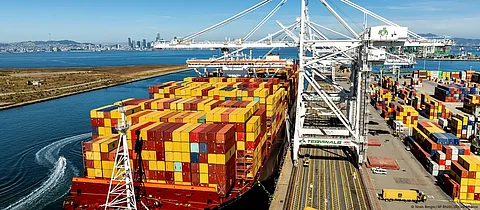

Donald Trump’s latest wave of sweeping tariffs on imports from over 90 countries came into force on Thursday, marking a significant escalation in Washington’s aggressive trade policy. The country-specific levies, branded as “reciprocal tariffs”, are part of Trump’s broader effort to reshape global trade in favour of the United States, which he has repeatedly claimed has been exploited for decades.
The new rates took effect just after midnight (Washington time) and are expected to have widespread implications for global trade, investment flows, and geopolitical relations. The tariff rates vary significantly—ranging from 10 percent for key allies such as the UK, to 41 percent for war-torn Syria.
India, already reeling from a recent 25 percent import duty on its goods, is now bracing for an additional 25 percent levy set to kick in on August 27 unless it halts oil imports from Russia. If implemented, this will raise India’s total tariff exposure to the US to 50 percent—among the steepest globally.
On Wednesday, Trump signed an executive order linking India's increased tariff directly to its continued trade with Moscow, in a move analysts say could set a precedent for targeting other nations dealing with Russia. Delhi has been given a 21-day window to respond.
In one of the most dramatic moves yet, Trump also announced a potential 100 percent tariff on foreign-made semiconductor chips. The measure is designed to pressure global tech companies to either shift production to the US or significantly increase their American investments.
This announcement came shortly after Apple revealed plans to invest $100 billion in its US operations, reportedly under intense pressure from the White House to move more of its supply chain stateside.
Trump defended the measures late Wednesday night on his Truth Social platform, claiming “billions of dollars” were flowing into the US due to the tariffs. “The only thing that can stop America’s greatness would be a radical left court,” he added, referencing an ongoing appeals court case assessing the legality of his executive authority over tariff policy.
Governments worldwide have scrambled over the past week to reach last-minute trade agreements with Washington before the new tariffs came into effect. While some, like the UK, Japan, South Korea, and the European Union, successfully negotiated reduced rates, others such as Switzerland, Taiwan, and Brazil were less fortunate.
Switzerland, hit with a 39 percent tariff, has called an extraordinary cabinet meeting on Thursday after its last-ditch diplomatic efforts in Washington failed to produce a breakthrough. Swiss President Karin Keller-Sutter held two days of emergency talks with senior US officials earlier this week.
Taiwan, a close US ally, faces a 20 percent levy but insists the rate is temporary. President Lai Ching-te confirmed that talks with Washington are ongoing.
Brazil, meanwhile, is facing a combined 50 percent duty, including a newly announced 40 percent penalty linked to the prosecution of former President Jair Bolsonaro. President Lula da Silva has voiced concern that the high tariffs could damage Brazil’s export competitiveness.
The European Union, which secured a framework agreement last week, will be subject to a unified 15 percent tariff rate across its exports to the US. This deal, however, supersedes existing product-level duties, meaning some goods such as cheese will now be taxed at the lower framework rate instead of a combined higher rate.
While India faces one of the steepest potential increases, other close US neighbours have also been affected. Canada’s tariff rate has been raised from 25 percent to 35 percent as punishment for what Trump described as its failure to curb the smuggling of fentanyl and other drugs across the US border. However, most Canadian goods are expected to remain exempt under the United States-Mexico-Canada Agreement (USMCA).
Mexico, too, was spared further increases to its 25 percent tariff after being granted a 90-day extension to reach a new trade agreement. China, still negotiating, faces a looming August 12 deadline, after which it could be hit with a 30 percent levy.
Several South East Asian countries, including Laos and Myanmar, were among the hardest-hit. With new tariffs of up to 40 percent, their largely export-dependent economies could suffer severe setbacks. Some analysts said these nations were possibly targeted due to their close trade links with China.
Despite the sweeping nature of the tariff regime, financial markets across Asia appeared relatively calm on Thursday. Major indices in Japan, Hong Kong, South Korea, and mainland China posted modest gains, while those in India and Australia registered slight losses.
Economist Bert Hofman of the National University of Singapore suggested the stability may be due to the tariffs bringing an end to recent trade policy uncertainty. “This is supposed to be it,” he said. “Now you can start to analyse the impact of the tariffs.”
Whether that impact will be inflationary for US consumers or merely redirect global trade flows remains to be seen. For now, the White House appears determined to press ahead with its “America First” trade policy, even as allies and rivals alike scramble to adjust.